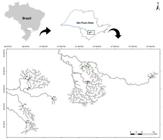ABSTRACT
Trophic structure of fish assemblages is one of the most sensitive indicators of changes in streams environments. Since it is crucial to understand the response of trophic groups to habitat alteration, our study aimed to address this research gap by assessing the influence of substrate composition, meso-habitat variability, and bank stability, on the richness, biomass, and number of individuals of carnivores, invertivores, omnivores, and herbivorous-detritivores. Using an electrofishing device, we sampled 13 Atlantic rainforest streams reaches in a degradation gradient, located in the upper Paranapanema river basin. Sample points were ranked using a physical habitat index. More pristine streams had high availability of twigs, trunks, rocks and boulders in the substrate, great meso-habitat variability, and the presence of roots, trunks, and rocks in the margins. Canonical correlations between habitat characteristics and trophic groups explained more than 90% of data variability. Richness and number of individuals of invertivores increased in more preserved stream reaches, while richness of carnivores and number of individuals of omnivores decreased. These results demonstrate that trophic structure varies according to level of degradation, and that invertivore richness represents the best indicator of fish trophic structure responses to physical habitat alterations in streams.
Keywords:
Abundance; Environmental Assessment; Invertivores; Richness; Substrate

 Thumbnail
Thumbnail
 Thumbnail
Thumbnail
 Thumbnail
Thumbnail
 Thumbnail
Thumbnail



